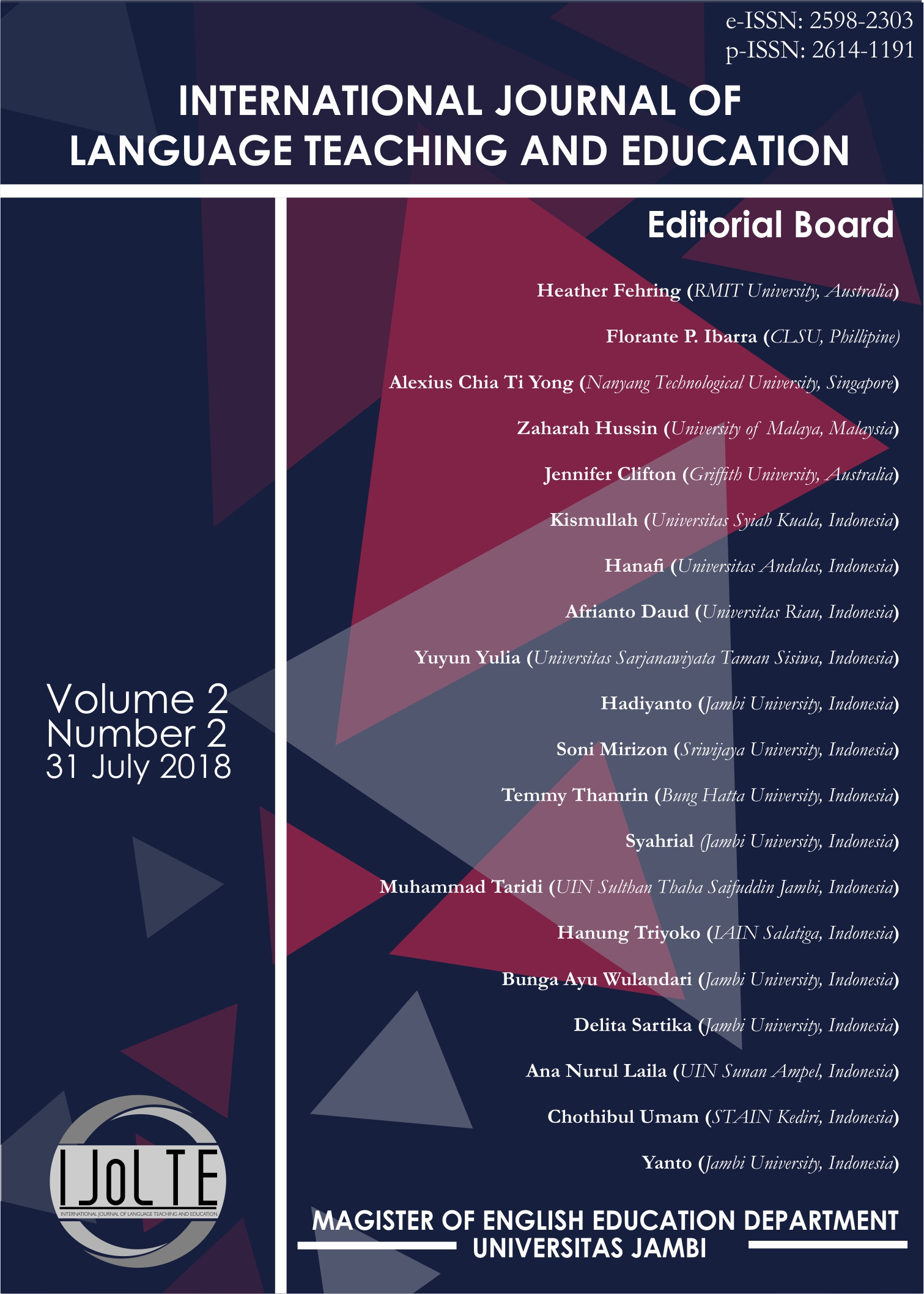Increasing Global Awareness through Professional Learning Community: A Study from LATTICE
DOI:
https://doi.org/10.22437/ijolte.v2i2.4965Keywords:
PLC, Profesional Development, LATTICE, Leraning CommunitiesAbstract
Using three components of PLCs by DuFour (2004), I explored the learning communities at LATTICE (Linking All Types of Teachers to International, Cross-cultural Education). DuFour (2004) argued that PLCs is a form of learning communities held at the school level to improve the school quality. It means PLCs happen in the school context. However, Easton (2011) contended that learning community could happen inside or outside schools. This paper intends to analyze a learning community at LATTICE in creating more global perspective teachers. The study found that PLC s can also occur outside schools by including participants other than teachers. Based on the interviews and observations analysis, this study found that LATTICE did reflect PLCs and significantly helped K-12 educators foster their global understanding.
Downloads
References
[2] Atknison, E. (2004). Thinking outside the box: An exercise in heresy. Qualitative inquiry, (10), 111-129.
[3] DoFour, R. (2004) What is a professional learning community. ASCD Journal, 61(8), 6-11.
[4] Drago-Severson, E. (2009). Learning adult learning: Supporting adult develop-ment in our school. California: Corwin.
[5] Dufour, Dofour & Eaker. (2012). A big picture look at professional learning com-munity. Solution Tree.
[6] Easton, L. B. (2011). Professional learning communities by design: Putting the learning back to PLCs. California: Corwin.
[7] Fullan, M. (2005). Professional learning communities writ large. In DuFour, R., Eaker, r., DuFour, R. (Eds.), On common ground the power of professional learn-ing communities (p. 209). National Education Services: Indiana.
[8] Glesne, C. (2011). Becoming qualitative researchers. Pearson. Boston: Massachu-setts
[9] Miles, M., & Huberman, M. (1994). Qualitative Data Analysis. Thousand Oaks, CA: Sage.
[10] LATTICE Brochure (n.d) LATTICE: Linking all types of teachers to international cross-cultural education.
[11] Louise, et al., (2006). Professional learning communities: A review of the litera-ture. Journal of Educational Change, (7) 221-258.
[12] Lunenberg, F. C., (2010). Creating a professional learning community. National Forum of Educational Administration and Supervision Journal, 27, 1-7
[13] Papanastasiou, E. C., Conway, P. F. (2002). Teacher professional development through LATTICE an international-intercultural project. Studies in Educational Evaluation, 28(2002), 305-328.
[14] Rosenholtz, S. (1989). Teachers’ workplace: The social organization of schools. New York: Teachers College Press.
[15] Schmoker, M. (2004). Start here for improving teaching and learning. School Ad-ministrator. 61(10), 48.
[16] Schwille & John. (2017). Internationalizing a school of education. International Race and Education Series. East Lansing: Michigan State University Press.
[17] Spreen, C. A. (2009). Teaching global awareness. TEAC’s 10th Annual Meeting. Chicago.
[18] Stoll, L., Bolam, R., McMahon, A., Wallace, M., & Thomas, S. (2006). Professional learning communities: A review of the literature. Journal of Educational Change, 7, 221-258.
[19] Whitehead, B., Bjoschee, F., & Decker, R. (2013). The principal: Leadership for a global society. Los Angeles CA: Sage.
Downloads
Published
Versions
- 2018-07-31 (1)
- 2018-07-31 (1)
How to Cite
Issue
Section
License
The Authors submitting a manuscript do so on the understanding that if accepted for publication, copyright of the article shall be assigned to International Journal of Language Teaching and Education (IJoLTe) and Magister Program of English Education Department, Universitas Jambi as publisher of the journal. Copyright encompasses rights to reproduce and deliver the article in all form and media, including reprints, photographs, microfilms, and any other similar reproductions, as well as translations.
IJoLTe keep the rights to articles that have been published. And, the authors are permitted to disseminate published article by sharing the link of IJoLTe' website. Authors are allowed to use their works for any purposes deemed necessary without written permission from IJoLTe with an acknowledgement of initial publication in this journal.
IJoLTe and Magister Program of English Education Department, Universitas Jambi, and the Editors make every effort to ensure that no wrong or misleading data, opinions or statements be published in the journal. In any way, the contents of the articles and advertisements published in IJoLTe are the sole and responsibility of their respective authors and advertisers.
If the article was jointly prepared by more than one author, any authors who submitting the manuscript warrants that he/she has been authorized by all co-authors to be agreed on this copyright and license notice (agreement) on their behalf, and agrees to inform his/her co-authors of the terms of this policy. IJoLTe will not be held liable for anything that may arise due to the author(s) internal dispute. IJoLTe will only communicate with the corresponding author.
By submitting the article/manuscript to this journal, the authors agree with this policy and consciously agree that IJoLTe does not provide royalties or other fees to the authors for their published articles. By agreeing this policy, IJoLTe ensures that published articles are publicly accessible and will be free of charge for the readers. No specific document sign-off is required.
Users of this website will be licensed to use materials from this website following the Creative Commons Attribution 4.0 International License. Please use the materials accordingly
You are free to:
- Share — copy and redistribute the material in any medium or format
- Adapt — remix, transform, and build upon the material for any purpose, even commercially.
- The licensor cannot revoke these freedoms as long as you follow the license terms.








1.png)
